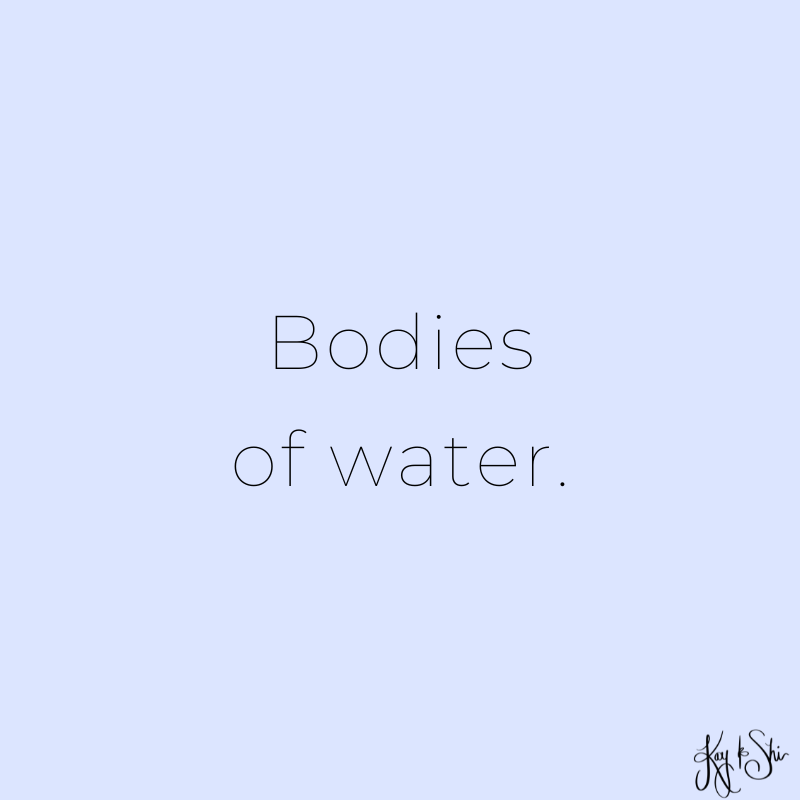Kay:
Hey there, family. We’re back again for our final installment of nature freak week and today we’re going to discuss bodies of water.
Shi:
Well, welcome back you freaks of nature. You nature freaks. We’re so glad you’re fellow freaks alongside us for this amazing planet. That is so beautiful. I was looking at our list. We talked about forests, and we talked about mountains, and we talked about animals, and now we want to talk about bodies of water. But I’m like, “Well, what about the deserts? And what about the tundra? And what about all of the amazing flora and fauna and other things that we didn’t get to touch?” So maybe we’ll have to do a freak week addition part two. But bodies of water are something that we think are just–as so many humans do naturally draw to them–so majestic, so reflective, so mysterious and so powerful.
Kay:
There are three bodies of water that they want to give a special shout-out to because we grew up with them here in our region. It’s actually a very special trio of bodies of water. The first body of water is that of Lake Tahoe, which is about a 30-minute drive from our hometown Reno, where we were born and raised in Reno, Nevada. So, 30 minutes away is Lake Tahoe, and the sister body of water to Lake Tahoe is called Pyramid Lake which is surrounded by an incredible amount of Native American mystery and then was home to many tribes and things and there’s a lot of local lore about Pyramid Lake. But those two lakes are some of the only lakes in the world that are connected by a river. So, there’s a river that flows from Lake Tahoe to Pyramid, and it is called the Truckee River. Now, if you don’t know this, most rivers flow from the top of a mountain or from a lake to the ocean. And the fact that these are two bodies of water, that get fed from one to the other and via a river, and the river does not flow to the ocean, makes our region’s three bodies of water pretty unique.
Shi:
I love it and they’re all connected, which is beautiful and just from the geographic standpoint, this means that the basin where Pyramid Lake is was actually a humongous body of water at one point and if you’re familiar with the Northern Nevada region, fun fact for you, it used to be part of Lahontan Lake. So, if you know where Lahontan Lake and Pyramid Lake are, you can imagine that that was all one body of water. So, no wonder it attracted a river, just like a little mini ocean way back in ancient times. But another special shout-out of a body of water in our region that’s worth mentioning is the Pacific Ocean. Now a little bit farther from us, we can’t even necessarily get to it in less than an hour, but in about four hours, we can be at the ocean. Our parents were raised by the ocean. So, there were lots of trips to the Pacific Ocean when we were younger and now, of course, our parents live cliffside of the amazing Pacific Ocean in Brookings, Oregon. Every time we’re there, we just marvel at the beauty, the magnitude, the depth of what is the ocean and I know there’s always a lot of reverence and grace as we observe the ocean.
Kay:
We’ve been lucky enough to experience both the Pacific and the Atlantic Oceans. The Atlantic Ocean didn’t come into our world a little bit more until we were older, but it’s been interesting to see the similarities and the differences. Now, both are giant and majestic. Both are incredibly beautiful, but the Pacific Ocean has a lot more movement than the Atlantic Ocean. Well, bigger waves and the salination is totally different. In fact, fun fact, at the point where the Pacific Ocean and the Atlantic Ocean meet, there is a definitive line in the water, and you can actually see that the Atlantic Ocean is a lighter color than the Pacific Ocean because of the different ecosystems that they have. So, there’s a point when you’re crossing that one giant 60% of the world, that’s all ocean where the two of them meet and you see the line and it’s pretty incredible. You can actually go check out videos on YouTube, it is really amazing to see. But we’ve had a lot more experience with that beautiful Pacific Ocean, but both of them hold those character qualities of majestic-ness, gigantic-ness, and the fact that they’re their whole own ecosystems and world underneath the water.
Shi:
I recently heard a discussion where they were talking about the fact that–and Kay, you and I have talked about this before–honestly, the air is like an ocean. That is what we breathe in and out just like fish breathe in and out the water. It’s what we all live in and so we live at the bottom of the air ocean. If you think about that, that’s kind of a trip.
Kay:
Does that mean we are bottom feeders?
Shi:
It kind of does. It really does.
Kay:
The lobsters of the land.
Shi:
But I always think about too, that turning point from the sand into the ocean and the way that it transitions into the next ecosystem and the next death. There’s still so much mystery around the ocean and truly one of the next frontiers. We all look up but looking down into the ocean there’s so much there and I think one of the things that we always talk about is how powerful the body of the ocean is. It’s majestic, it’s amazing, and you love it, and you feel tiny next to it, and I don’t want to mess with the ocean. I want to like dip my toe in, ride boats on it, fly over it, but I am not interested in super scuba diving or little boat adventures, or fishing out there. I want to be as respectful and safe with the ocean as possible.
Kay:
If you’ve been lucky enough to experience the ocean, you’ve likely had that feeling of reverence, especially in the fact that it is the largest perpetual motion machine in the world. The lapping of the waves never stops. Be it Pacific or Atlantic the waves are always going. The tide is always pulling in and out. It’s one of those things that’s almost as sure as the sunrise and the sunset are the tides pulling in and out and the waves always going. It has its own rhythm, its own groove, and it moves automatically without humans being there to make it move and it has an incredible power in the amount of motion that it creates.
Shi:
We’ve yet to get to experience the Indian or the Arctic Oceans but look forward to putting those on our bucket list and getting to see those beauties as well. Love that the tides move to the rhythm of the moon and that the oceans respond to the moon and just understanding that relationship demonstrates how connected everything in nature is. As we look back on what we’ve talked about, all of these are codependent and interdependent on each other. The ecosystem is strong but delicate because there are so many pieces that feed each other and that we’re so intricately woven together that they think humanity is waking up to. We know if you’re a listener, you’re part of that. Let’s save the planet. Let’s try if we can preserve it not only because it’s so beautiful, but also because we all live here and our lives sort of depend on it. So, hoping that fellow nature freaks out there as we talk about water, as we talk about animals, as we talk about mountains, as we talk about trees, as we talk about the beauty and majesty of nature, that we all do our own part to try to help preserve it for generations to come.
Kay:
We’ve had so much fun getting to geek out and freak out here on nature week. We absolutely love nature. We hope that you do too, and we hope that you come over on into the Facebook group. Let us know what portion of nature do you love? How do you support it and how can we support it too in the way that you do as well? We’ve enjoyed this week here on the Kay & Shi Show. Thanks, everyone.
Shi:
Thanks for tuning in. We’re in your corner and we’re rooting for you.



